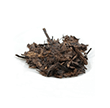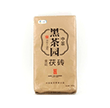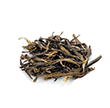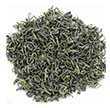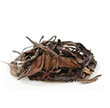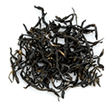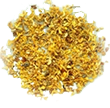About White Tea
Oxidization: Lightly oxidized
Growing Regions: Fujian, Jejien
Best Seasons To Purchase: Spring and Summer
Pharmacological Elements: Polyphenols, amino, potassium, calcium, magnesium, zinc, manganese, catechin, gallic acid, theobromine and caffeine
White Tea is one of China's special treasures, made from the youngest and most tender hand-picked leaf tips and buds. These give a fresh and delicate flavour and a snowy/silver coloured brew from which White Tea gets its name. Because of the laborious and detail oriented process, it's also one of the most expensive teas produced.
White Tea is mainly produced in the Jianyang, Fuding and Songxi counties in Fujian Province. These hilly territories with their red and yellow mountain soils, year round mild climate and abundant rainfall (in Fuding for example, the average annual temperature is 18.5°C / 65.3°F and annual precipitation is about 1660 mm/65 inches), contribute to White Tea's unique character. Taiwan also produces a small amount of White Tea.
The most popular types of White Tea are White Peony and Silver Needle (Bai Hao). White Peony that is made from the first and second tips of a tea stem is the best quality and gets its name from the way the brewed leaves seem to bloom like the buds of the first flowers in springtime.
Silver Needle is the most expensive of the White Teas. It is made only from the single tips of the tea stem which when dried, look like silver needles. The tea has a light yellow colour and refreshing taste and aroma.
Production of White Tea
The production process is generally divided into 3 steps:
Withering
Picked leaves are spread out (inside and/or outside in the sun) to soften the cell walls of leaves. This draws the moisture to the surface for evaporation, softens the leaves, begins natural enzymatic oxidization and sets up the next stage of processing. This also reduces the grassy taste of tea leaves. The key to making excellent White Tea lies in the withering which is further divided into outdoor and indoor steps. The best combination seems to be outdoor withering of the leaves on a mild summer day, followed by further withering done inside. The stems are then removed from the leaves, the natural waxy film coating is removed and they are slow-fire baked until dry. When the moisture content is reduced to about 4% to 5% , the leaves are then packaged.
Rolling/Forming
Leaves are passed through hot and/or cold rollers to slightly break down the leaves, which establishes the shape of the leaves and intensifies the tea flavour.
Drying
Establishes the final moisture content of the leaves, stops oxidization, prevents mold growth, removes any grassy leaf taste and develops the tea's aroma. Sun drying, pan heating and hot air methods are used.
A Quick History Of White Tea
White Tea first appeared in the Northern Song Dynasty (960 - 1127). It was during this period that the first paper money and gunpowder were used and a standing navy and the location of true north on a compass were first established.

The first mention of White Tea appeared in "Treatise on Tea”, written by the Emperor Huizong (1107-1110). A tea connoisseur, White Tea was his favourite and his book included highly detailed descriptions and rules for the making and judging of tea.
In 1769, the first Silver Needle Pekoe Tea was developed and in 1857, tea plants were found in Fuding County in Fujian which yielded a superior White Tea. In 1885, Silver Needle Tea was developed and then White Peony Tea in 1922. In 1968 the first exports of White Tea were made possible by new techniques of growing and processing.
Flavours of Chinese White Tea
To learn about the flavours of White Tea , see the Flavour Guide
Storing White Tea
Because White Tea is exposed to only a small amount of processing, the leaves are subject to natural enzymatic breakdown by oxidation just like any other organic material. White Tea is best kept in a cool , dry place in an airtight container or even in a refrigerator. We recommend refrigeration which actually improves the taste of the tea, as well as making it last much longer. However, if refrigerated storage is used, the tea should be kept refrigerated at all times as successive warming and cooling will degrade the tea.
White Tea And Health Benefits

There are many health benefits attributed to drinking Chinese tea, ranging from feelings of well-being to near magical cures. For the average Westerner, much of this interest is focused on ancient claims related to weight loss and more modern claims of cancer-prevention due to tea's anti-oxidant properties. Each person must make their own assessment of the facts. While there are centuries of tradition and empirical evidence from Traditional Chinese Medicine, there is little modern scientific consensus that supports the health benefits of tea. Even the effect of anti-oxidants to prevent anything has recently been drawn sharply into focus.
We believe that any food product can have positive and/or negative health effects and in varying degrees for different individuals. We do not recommend teas on the basis of health benefits and at this point, do not think it is prudent to recommend tea-drinking for anything other than to enjoy the wonderful flavour and the experience of enjoying tea alone or with friends.
For reference purposes only, we list the benefits of White Tea as commonly recognized in Traditional Chinese Medicine:
- Can reduce inflammation caused by rheumatoid arthritis
- Can control insulin secretion
- High source of Vitamin A, can prevent dry eyes and night blindness
- Can reduce radiation levels and repair DNA damage
Caffeine
It is common to hear people say “Tea has much more caffeine than coffee”. It is just as common to hear the opposite point of view. In fact with all the varieties of teas and coffees available, the different methods of manufacturing and preparing them for consumption and the different amounts consumed, both statements are in need of significant qualification.
So how much caffeine does tea and coffee have? Scientific studies and consumer group reports can both be less than detailed about what teas were used in their research. We will refer to a well detailed study published by the British Government (Survey of Caffeine Levels in Hot Beverages, Food Standards Agency, UK, August 2004):
- All Teas: mean 40 mg per serving
- Instant Coffee: mean 54 mg per serving
- Ground Coffee: mean 105 mg per serving
It has been generally believed that Chinese Green Tea has less caffeine than Black Tea. There is much study and discussion on this subject which suggests that his may not be the case. In fact Green Tea may have more caffeine than Black Tea. The confusion has been the result of more broad and unqualified statements that compare apples to oranges and not apples to apples, so to speak.
Most Black Tea exported to the West is from India and the Camellia assamica plant from which Indian tea is made produces higher levels of caffeine than from the Camellia sinensis variety that is used for Chinese teas. Furthermore, the oxidization process used in making Chinese Black Teas appears to reduce caffeine content rather than increase it as previously thought. So when you compare Chinese Green Tea to Chinese Black Tea, caffeine content in Chinese Green Teas seems to be higher than in Chinese Black Teas. Both are less than Indian Black Teas and all teas are significantly less than coffee.
With White Teas being only lightly-oxidized, caffeine levels in general can be assumed to be slightly less than that of Green Tea and higher than most other teas.
(Note: We use the term “Chinese Black Tea” as it is commonly used in the West to describe what are actually known in China as Red Teas. The true Chinese Black Teas as they are known in China are the post-fermented, aged teas such as Pu-Erh Tea).
But there is a way to reduce the caffeine level of any tea if you are sensitive to it. Any tea is

best made using the traditional Chinese method of tea-making known as Gong Fu Cha (Tea With Great Skill). This highly controlled method of tea-making is characterized by using small teapots and multiple brews with very short steeping times of just a few seconds. This intensifies the flavour of any tea and reduces the caffeine consumed compared to Western methods of tea-making. In Gong Fu Cha, the first brew is for washing the leaves and is poured away, so it is not consumed. This also has the effect of washing away much of the caffeine which is highly soluble in water.
To learn about tea-making using the traditional Chinese Gong Fu Cha (Tea With Great Skill) technique, read our guide Gong Fu Cha - The Complete Guide To Making Chinese Tea by Daniel Lui.
 Top of Page
Top of Page

Ask The Tea Wizard
Don't know which tea is right for you? Answer a few questions and the Online Wizard will show you all the Chinese teas that suit your taste.


